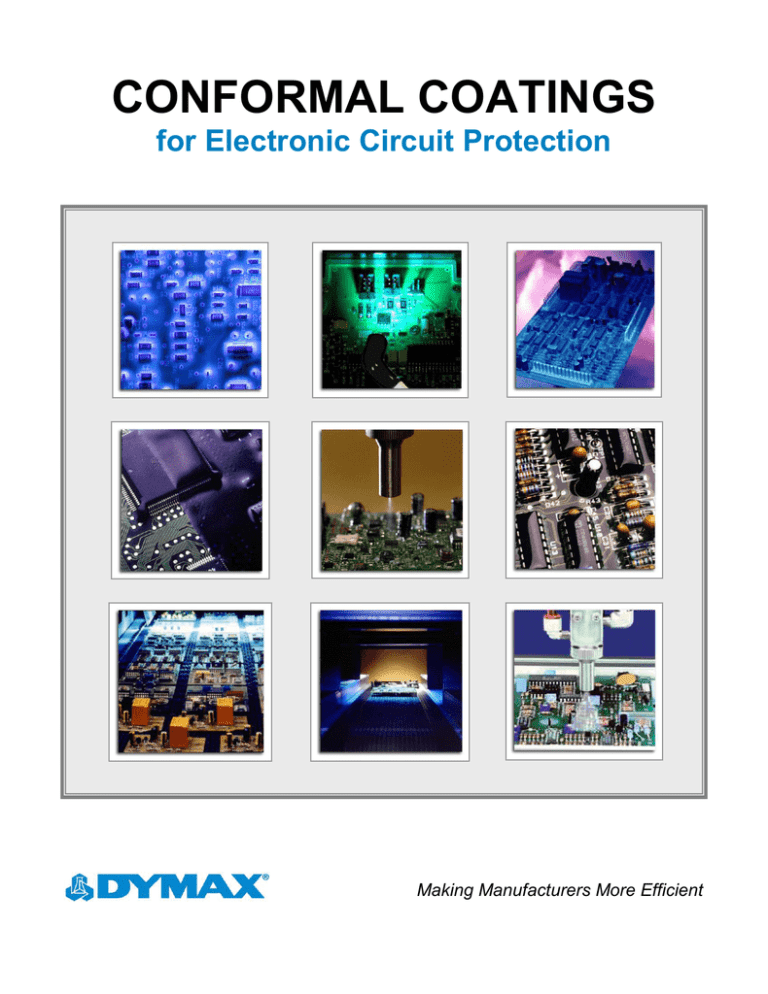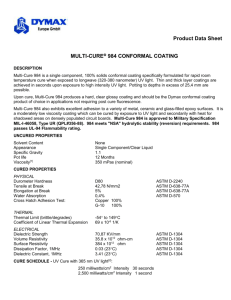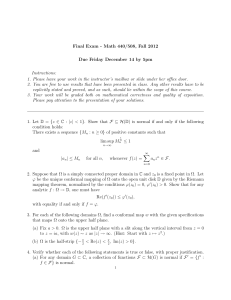
CONFORMAL COATINGS
for Electronic Circuit Protection
Making Manufacturers More Efficient
INTRODUCTION
Dymax UV conformal coatings have been used to protect printed circuit boards for over twenty years in many highreliability applications, including military, aerospace, medical, automotive, appliance, and telecom applications.
Conformal coatings are often applied to printed circuit boards to improve circuit reliability in harsh environments.
Dymax light-curable conformal coatings are engineered to protect circuit boards from humidity, dust, fungus, and
other contaminants that can cause either current leakage or corrosion.
WHY USE DYMAX UV CONFORMAL COATINGS?
SUPERIOR PROCESSING
SUPERIOR PROTECTION
Easier automation
Full cure in seconds
No racking, ovens, or humidity chambers
No risk of silicone migration
IPC-CC-830, Mil-I-46058C, and UL listed
Excellent environmental resistance
High dielectric strength
Tenacious adhesion to flex circuits
Solvent free
Most are Isocyanate free
Thick coatings in a single application pass
Repairable
One part, no mixing or viscosity problems
Low stress under thermal cycling
Non-slumping viscosities
Excellent abrasion resistance
Black coatings help hide proprietary circuitry
Protection up to 175C
SELECTING A DYMAX CONFORMAL COATING
WHEN SELECTING A UV-CURABLE CONFORMAL COATING, THERE ARE THREE MAIN THINGS TO CONSIDER:
1. Coating Application and Curing
2. Coating Adhesion to PCB and Assembly Materials
3. Coating Properties and Specifications
COATING APPLICATION AND CURING:
Typically, the best way to apply Dymax conformal coatings is by selective spray application. This method ensures
that areas which must be protected are coated at the desired thickness and areas which should not be coated
remain uncoated. In addition, selective spray application can be used to avoid depositing the UV coating
underneath components where the material is shadowed from light.
Dymax conformal coatings cure in seconds under high-intensity UVA and blue visible light. With proper coating
application, UV cure is a very simple processing step.
Conformal Coatings for Electronic Circuit Protection
Page 2
COATING ADHESION TO PCB AND COMPONENT MATERIALS:
To provide effective protection to PCB components and surfaces, conformal coatings must wet well upon application
and adhere well after cure. Optimal results are obtained with clean boards.
CURED COATING PROPERTIES AND SPECIFICATIONS:
Dymax conformal coatings are excellent insulators. In practice, properties affecting the degree of protection include
coating thickness (thicker is typically better), moisture absorption (less is better), and resistance to other environmental
stresses. Flexible grades are designed to enhance thermal cycling performance. Hard, more rigid grades are preferred
to enhance chemical resistance in harsh environments. Required specifications are also important considerations.
Dymax conformal coatings are used in a multitude of military and automotive applications. Dymax carries an array of
MIL-I-46058C listed, IPC-CC-830-B approved and UL recognized coatings.
CONFORMAL COATINGS
RELIABLE BOARD PROTECTION IN SECONDS
Product
Number*
Description
Viscosity
(cP)
Durometer
Hardness
Modulus of
Elasticity
(psi)
Dielectric
Strength
(Volts/mil)1
Approvals
6,000
-
104,000
PENDING
-
9451
True black color for covering sensitive
information; secondary heat cure for
shadowed areas; optimized for single
pass coating
9481-E
Secondary moisture cure for shadowed
areas; low viscosity for thin coatings; low
surface energy for difficult-to-wet
components and assembly materials;
high chemical and abrasion resistance
125
D75
21,800
>1,500
MIL-I-46058 listed
IPC-CC-830 approved
UL recognized
9482
Secondary moisture cure for shadowed
areas; superior re-workability; thermal
shock and chemical resistance; blue
fluorescing
1,100
D70
40,000
1,100
-
984-LVUF
Secondary heat cure; Isocyanate free;
low viscosity for thin coatings; rigid for
high chemical and abrasion resistance
150
D80
60,000
1,800
MIL-I-46058 listed
IPC-CC-830 approved
UL recognized
987
Secondary heat cure; Isocyanate free; low
viscosity for thin coatings; rigid for high
chemical and abrasion resistance; low
surface energy for difficult-to-wet
components and assembly materials
150
D85
130,000
>1,500
MIL-I-46058 listed
IPC-CC-830 approved
9-20351-UR
Secondary heat cure; Isocyanate free;
high viscosity for easy one-pass coverage
of high-profile leads and tall components;
low modulus for superior thermal cycling
performance; red fluorescing
13,500
D60
2,700
500
-
9-20557
Secondary heat cure for shadowed areas;
Isocyanate free; medium viscosity for
wetting components; low modulus for
enhanced thermal cycling performance
2,300
D60
13,000
>1,500
MIL-I-46058C listed
IPC-CC-830 approved
UL recognized
9-20557-LV
Secondary heat cure for shadowed areas;
Isocyanate free; low viscosity for thin
coatings; low modulus for enhanced
thermal cycling performance
850
D70
55,000
>1,500
MIL-I-46058C listed
IPC-CC-830 approved
*NOTE: Other grades are available for specific applications requiring physical properties that are different from the standard products listed here.
1
1-mil = 0.001 in = 0.0254 mm
Conformal Coatings for Electronic Circuit Protection
Page 3
SELECTIVE SPRAYING OF
UV CURABLE CONFORMAL COATINGS
The effectiveness of a conformal coating is dependent upon how well it is applied. The most effective method of
applying a UV conformal coating is selective spraying. Selective spraying allows for sufficient coverage of all
areas that require coating while avoiding those areas that must not be coated. Selective spraying is typically
accomplished with three- or four-axis robotic systems.
In designing and operating a selective-coating system, there are several key factors to consider. These include
the pressure pot, fluid lines, application equipment/process, and the compatibility of the coating with all wetted
surfaces. Most importantly, the accuracy of the spray pattern desired should be considered in choosing a spray
system to avoid coating application in shadow areas.
PRESSURE POT
One of the first steps in designing a selective-coating operation is to determine the appropriate coating package
size and corresponding pressure pot. Most customers purchase Dymax conformal coatings in 1-liter bottles or
15-liter pails. In most cases, Dymax conformal coatings are stable in sealed pressure pots for extended periods
of time (6 months or more).
FLUID LINES
UV-curable coatings can react in the presence of fluorescent overhead lighting. Black, opaque fluid lines will
prevent curing in the fluid lines. Opaque polyethylene, polypropylene, or Teflon ® fluid lines are typically
recommended to ensure material compatibility.
APPLICATION PROCESS
Conformal coating resins can be applied using simple hand-application equipment, but are most commonly
applied using robotic selective-spray systems. Selective-spray methods include either atomized or non-atomized
spray techniques. An atomized process utilizes air to produce a fine mist. A non-atomized process is air free and
relies on a variety of spray pattern designs to produce a uniform film. The technology is ideal for lower viscosity
formulations.
Selective-spray pattern widths can vary from 0.125" to over 2" and are highly dependent upon the height of the
applicator from the work surface. A thickness of 0.002" or greater can be achieved in a single pass. Coating
thickness is controlled by robot speed and a flow regulator on the spray valve.
Aside from the obvious quality and repeatability benefits, robotic application aims to eliminate manual masking
operations. The success or failure of satisfying this objective lay not just with the applicator, but on the capability
of the robot itself. It is critical to explore the necessary axes of motion required to meet your objectives. Two-,
three-, and four-axis robots are available to access all necessary coating areas while avoiding keep-out areas. In
areas where a spray valve alone either can’t access an area or covers too much area, a separate needle
dispensing valve (with optional tilt) can be incorporated into the selective-coating system.
Conformal Coatings for Electronic Circuit Protection
Page 4
COMPATIBILITY OF DYMAX COATINGS WITH DISPENSING EQUIPMENT MATERIALS
Dymax conformal coatings are readily dispensed through a wide variety of commercially available spray valves,
pressure pots, and pail/drum ram pumps (for thicker coatings). When selecting a dispensing system, make sure
that wetted equipment materials are compatible with Dymax products. Incompatible wetted components can be
attacked by Dymax coatings or may cure prematurely.
Recommended Materials for Dispensing Equipment:
Acetals
Hard Chrome
Opaque HDPE,
HDPP
Opaque Silicone
Nylon (pure)
Opaque Teflon
Stainless Steel (300 series, nonmagnetic)
Common Materials to Avoid in Dispensing Equipment:
Aluminum
Brass
Bronze
Cast Iron
Copper
Mild Steel
N-Butyl “O” Rings
Polycarbonate
Polyurethane
PVC
Stainless Steel (400 series,
magnetic)
Zinc
CURING DYMAX CONFORMAL COATINGS
The following are important guidelines when selecting a light source for curing a Dymax conformal coating:
Your success with UV-curable conformal coatings is partly dependent on the curing system employed. In general,
higher-intensity lamps yield faster, more efficient cures and better overall performance.
HIGH-INTENSITY LIGHT SOURCES FOR UV-CURABLE CONFORMAL COATINGS
There are two basic types of light sources that can be used for curing UV-curable conformal coatings. Dymax
supplies both types.
1. Mercury Arc Lamps – This type of light source typically
provides 50-1000 mW/cm2 of UVA light at the curing
surface. The major advantage of these systems is lower
capital cost. Bulb degradation must be monitored with a
radiometer to ensure a controlled process. These systems
are appropriate for lower-volume applications where
conveyor speeds of 1 to 5 feet per minute are acceptable.
2. Electrodeless Lamps – This type of light source generally
provides 1000 - 3000 mW/cm2 of UVA light at the curing
surface. The major advantages of these systems are
faster cure and higher throughput. While capital costs are
higher, total cost of ownership is lower due to longer bulb
life, less maintenance, and better energy efficiency. They
are recommended for medium- to high-volume applications.
Conformal Coatings for Electronic Circuit Protection
Page 5
ESTABLISHING A CONTROLLED CURE PROCESS
Guidelines for establishing a controlled UV cure process are discussed in the Dymax Comprehensive Guide to
UV Light-Curing Technology (available at www.dymax.com or by contacting Dymax Application Engineering at
877-396-2988).
Curing consistency is maintained by following these simple steps:
1. Establish the lower limit lamp intensity/energy needed for curing your part
in your specified time frame. This step requires a radiometer.
2. If using mercury arc lamps, choose a lamp system and process settings
such that a new bulb provides 3-4 times the energy required for your
process. If using electrodeless lamps, choose process settings (exposure
time or conveyor belt speed) such that a new bulb provides 2-3 times the
energy required for your process.
3. Monitor lamp output with a radiometer and change the bulbs when they
approach the established energy limit of your process.
SECONDARY HEAT CURE
Where significant deposition of UV conformal coating occurs in shadow areas, a secondary heat application step
can be used to affect cure in those shadow areas. Recommended cure schedules are 110oC for 1 hour or 120oC
for 30 minutes.
SECONDARY MOISTURE CURE
Dymax 9481-E and 9482 cure primarily with light, but also have the ability to cure with moisture in shadowed areas.
Heating boards in an oven or exposing them to higher relative humidity after coating will accelerate moisture curing
of shadow areas.
REWORK AND REMOVAL OF UV CONFORMAL COATINGS
INTRODUCTION
The purpose of conformal coatings is to protect PCBs and components from environmental attack or stress. They
function by adhering tenaciously to PCB/solder/component surfaces through environmental stresses such as
humidity and water exposure, chemical and particulate exposure, and heat and cold. The same properties that
make a conformal coating a good protective coating make its removal more difficult.
In general, solvent-based, non-cross-linked varnish-like coatings (not supplied by Dymax) will be relatively easy to
remove with solvents. Other chemistries with relatively low adhesion to electronic surfaces, particularly silicones,
can be removed mechanically. Dymax UV conformal coatings are cross-linked coatings that are designed to form
strong bonds to electronic surfaces. Therefore, somewhat more aggressive removal options are required for
rework compared to solvent-based systems and silicones.
CHEMICAL REMOVAL
Removing cured conformal coatings by chemical treatment requires immersion of the coated board or treating
localized areas with the chemical stripping solution.
Several companies manufacture materials which
dissolve/attack cross-linked conformal coatings. Suppliers of these materials can recommend handling procedures.
The list at the top of page 7 includes some suppliers of coating removal solvents.
Conformal Coatings for Electronic Circuit Protection
Page 6
CHEMICAL REMOVER SUPPLIERS
COMPANY
PRODUCT
TELEPHONE
NUMBER
Savogran Corporation
259 Lenox Street
Norwood, MA 02062
Kutzit or Strypeeze
Products are sold through local paint,
hardware, and home centers.
800-225-9872 www.savogran.com
Dynaloy, Inc.
1535 E. Naomi Street
Indianapolis, IN 46203
Dynasolve Uresolve Plus SG
Products are sold through authorized
distributors.
800-669-5709
317-788-5694
Tech-Spray
1001 N.W. 1st Avenue
P.O. Box 949
Amarillo, TX 79105
(for street address use 79107)
Fine-L-Kote Remover 2510
Products are sold through authorized
distributors.
800-858-4043 www.techspray.com
Jasco, Inc.
1008 N. Fuller Street
Santa Ana, CA 92701
Jasco Premium Paint and Epoxy Remover
Products are sold through local paint,
888-345-2726 www.jasco-help.com
hardware, and home centers and distribution.
WEB SITE
www.dynaloy.com
NOTE: It is important to consult with your company’s health and safety department prior to using any of these products. Dymax lists the
above products for conformal coating removal, but no claims or warranties are implied regarding their effectiveness for specific applications.
HEAT REMOVAL
Two techniques are useful for removing cured conformal coating depending upon the temperature sensitivity
of the components present on the circuit board.
1. For heat-sensitive areas requiring repair, heat the entire board to
150C and mechanically strip the coating as it softens while still hot.
2. For repairing areas not particularly sensitive to temperature, use a
hot-air de-soldering tool or a solder gun to remove spot coatings.
Apply the heat source to the treatment area and remove coating as it
softens.
MECHANICAL REMOVAL
Comco, Inc.
2151 N. Lincoln Street
Burbank, CA 91504-3344
800-796-6626
818-841-5500
www.comcoinc.com
Conformal Coatings for Electronic Circuit Protection
The company manufactures a Micro-Blaster System that safely
removes cured coating with a pressurized abrasive. The abrasive
is easily removed from the surfaces without danger to the
components or reworking process.
Page 7
DYMAX CONFORMAL COATING APPROVALS
MIL-I-46058C Listed
IPC-CC-830 Approved
UL Recognized
9481-E
984-LVUF
9481-E
984-LVUF
9481-E
984-LVUF
987
9-20557
9-20557-LV
987
9-20557
9-20557-LV
9-20557
FILM COVERAGE
1 Liter of Dymax coating will cover the following
areas at the film thicknesses shown:
Thickness
Square Feet
0.001"
0.002"
0.003"
343
173
114
0.004"
0.005"
0.010"
86
68
34
Note: The figures shown above assume the total use of
a liter of adhesive without any allowance for waste,
overspray, or any other unused amount.
© 2003-2016 Dymax Corporation. All rights reserved. All trademarks in this guide, except where noted, are the property of, or used under license by Dymax Corporation, U.S.A.
Technical data provided is of a general nature and is based on laboratory test conditions. Dymax does not warrant the data contained in this bulletin. Any warranty applicable to the product, its application and use is strictly limited to that contained in Dymax
standard Conditions of Sale published on our website. Dymax does not assume responsibility for test or performance results obtained by users. It is the user’s responsibility to determine the suitability for the product application and purposes and the suitability for use in
the user’s intended manufacturing apparatus and methods. The user should adopt such precautions and use guidelines as may be reasonably advisable or necessary for the protection of property and persons. Nothing in this communication shall act as a representation
that the product use or application will not infringe on a patent owned by someone other than Dymax or act as a grant of license under any Dymax Corporation Patent. Dymax recommends that each user adequately test its proposed use and application before actual
repetitive use, using the data in this communication as a general guideline.
LIT204
7/26/2016
Dymax Corporation
860.482.1010 | info@dymax.com | www.dymax.com
Dymax Oligomers & Coatings
860.626.7006 | info_oc@dymax.com | www.dymax-oc.com
Dymax Asia (H.K.) Limited
+852.2460.7038 | dymaxasia@dymax.com | www.dymax.com.cn
Dymax Europe GmbH
+49 (0) 611.962.7900 | info_de@dymax.com | www.dymax.de
Dymax UV Adhesives & Equipment (Shanghai) Co. Ltd.
+86.21.37285759 | dymaxasia@dymax.com | www.dymax.com.cn
Dymax Asia Pacific Pte. Ltd.
+65.6752.2887 | info_ap@dymax.com | www.dymax-ap.com
Dymax Engineering Adhesives Ireland Ltd.
+353.1.231 4696 | info_ie@dymax.com | www.dymax.ie
Dymax UV Adhesives & Equipment (Shenzhen) Co. Ltd.
+86.755.83485759 | dymaxasia@dymax.com | www.dymax.com.cn
Dymax Korea LLC
+82.2.784.3434 | info_kr@dymax.com | www.dymax.com/kr




